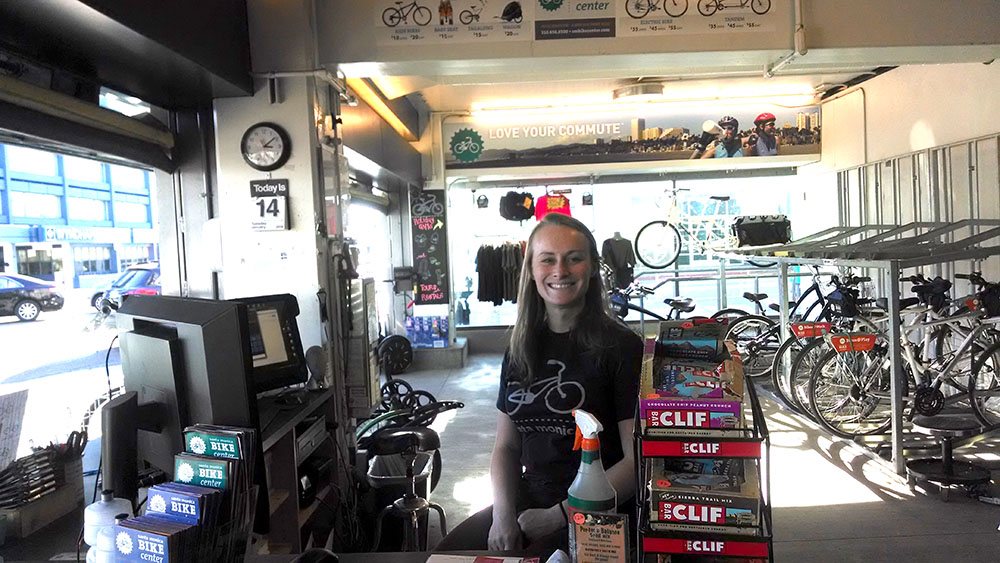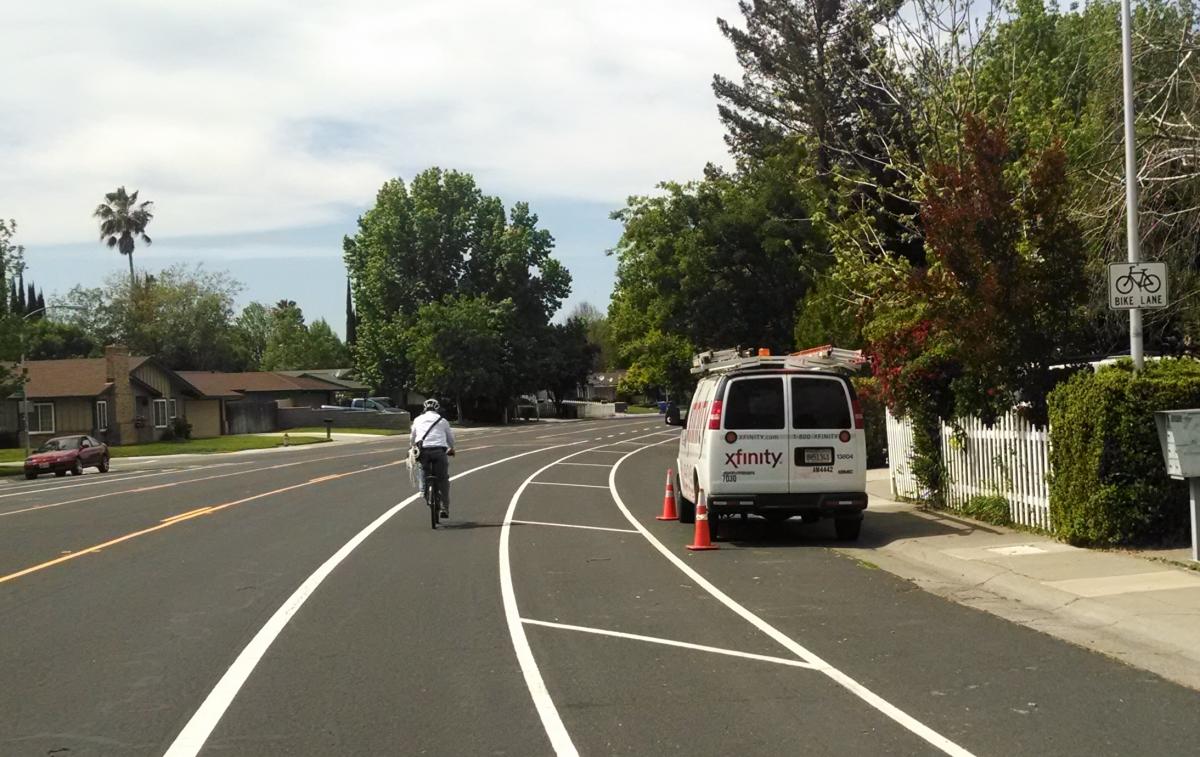DISCOVER YOUR LOCAL BICYCLING COMMUNITY
Find local advocacy groups, bike shops, instructors, clubs, classes and more!
How Can Laws Promote Bicycling?
Over coming months, we’re breaking down the building blocks of a Bicycle Friendly Community, and the first step is a solid legal foundation. While we’ve made many gains over the years, there are still plenty of examples “legal impediments” to bicycling. Last week, we looked at those impediments in more detail. Today, I’m looking at the oppostie: the city ordinances that improve or promote bicycling, which is a good marker for a Bicycle Friendly Community.
One easily visible example is a bicycle parking ordinance like the one in Santa Monica, Calif., which not only ensures an adequate supply of racks at destinations, but also requires event organizers to have monitored bicycle parking for 200 – 250 bikes if attendance is expected to reach 1,000 or more (requiring 3 attendants).

Proceeds from contracts for Bike Parking Valet Service helps to fund numerous educational programs of the Santa Monica Bike Center.
Better yet, the Santa Monica Bike Center, a non-profit and League Platinum Bicycle Friendly Business, is often contracted to provide this service, and the funds raised subsidize and expand the Center’s educational programs. When other event participants come to realize how much easier it is to arrive by bike (and have free parking valet service!) the word spreads and events become bicycle attractors rather than a frustrating cause of increased congestion.
Twenty is Plenty
It was with great joy that I heard from Rob Sadowsky of Bicycle Transportation Alliance (BTA) in Portland that BTA is working on a campaign to allow their Neighborhood Greenway streets (also known as bicycle boulevards) to be signed for a speed limit 5 miles per hour slower than the current minimum speed limit. This effort will be followed by a campaign to get Oregon’s minimum speed lowered from 25 to 20 miles per hour. What a difference this could make in decreasing crashes and the severity of crashes! And having bike streets (as they are called in Germany) with a 15 mph speed limit means the street is truly optimized for bicycle travel priority, with zero incentive for motorists to be using them instead of an adjacent arterial. This would make these special streets more like those in Europe where cyclists outnumber car drivers and set the speed. For instance, the typical bike street in Germany and Holland is only about 18 mph.
Bicycle Laws 101
So what other laws propel a city toward greater bicycle friendliness? There are of course many, but most are at a state level. The League has a wonderful resource called Bike Law University, which describes both good and bad state laws and why they matter, how they came about and advocacy efforts to make them better. Included in the project are: safe passing laws; protection of vulnerable road users; the Idaho stop law; red light exception laws, and others. In some cases cities have attempted (and some have succeeded) in enacting these laws on their own without state-wide application.For instance, I’ve now visited a few cities where the advocates are pushing for an Idaho stop law, including Corvallis, Ore. Thirty years ago, Boulder, Colo., adopted a provision allowing cyclists to pass stationary cars on the right as long as they stop before the first vehicle in line at a stop sign preparing for a right turn. Boulder was also the first community in Colorado to adopt exemptions to when a bicyclist shall “ride as far to the right as practicable.”
City Ordinances/Policies
Other laws or policies that allow for a more bicycle friendly community include the adoption of a Complete Streets Policy and Zoning Ordinances that encourage mixed-use development and discourage an abundance of surface lot parking lots.
 A Complete Streets policy in Sacramento, Calif., helped usher in this buffered bike lane.
A Complete Streets policy in Sacramento, Calif., helped usher in this buffered bike lane.
The most progressive cities are now eliminating car parking minimum requirements in downtown areas and instead instituting maximums. San Francisco and Seattle are examples of cities that have moved in this direction understanding that requiring new parking ramps/lots is a cost that is passed onto everyone, effectively providing a huge subsidy to car drivers.
Of course the same criticism can be directed at employers who provide free parking to their workers. California has pioneered what’s called the “parking cash out” (found in their Health and Safety Code), which says large employers must give employees the option of trading that free parking space for its cash equivalent. Even better, the law also stipulates that cities are required to reduce any parking requirement by the number of employees that cash out, making it a win-win for everyone.
Road Design Standards
In addition, standards can be adopted by local units of governments that allow for improved conditions for cyclists. For instance, in Oakland, Calif., they have guidelines that allow for roads to be narrowed to 10 feet (allowing for wider bike lanes), and a stronger standard for sharrows. So, instead of placing a sharrow a minimum of 11’ from the curb or parking lane, Oakland’s standard calls for a minimum distance of 12’ to provide more clearance for the cyclist from the door zone.
Fortunately, you don’t have to live in Oakland to experience more bike friendly design standards. Previous rigid roadway design policies are now allowing for greater flexibility nationwide. For instance, the AASHTO ‘Green Book’ now says 10’ lanes are acceptable on collectors and arterials and lists some of the many benefits of narrowing travel lanes including allowing for bike lanes. Furthermore the 2011 edition states that, “… mobility is often balanced against the need to provide direct access as well as the need to accommodate pedestrians, bicyclists, and transit users.” Translation: It’s okay to make the safe movement of all road users a higher priority than moving cars through an area as quickly as possible.
And now we also have new exciting guidance with NACTO that is opening up even greater flexibility for creative bikeway design, including two-way cycle tracks (protected bike lanes). (More on how this new treatment is being implemented all over the country, its special design challenges and where it can truly be safe and transformative in a future blog).
But the next blog coming is this: Tricks to get around bad laws (or rigid standards), increase public awareness and boost ridership in the process! Stay tuned!